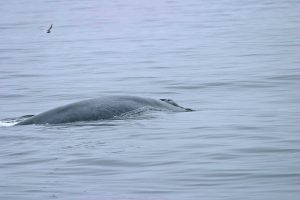Blue whale
The blue whale (Balaenoptera musculus) is the largest known animal in the history of the planet. It can reach the astounding size of over 33 m in length, weighing in at 190 tons. However, the average size is about 70 tons, which is still more than 30 times heavier than the largest elephant. A man of average size would be able to crawl through the blue whale’s largest blood vessels and the animal’s heart is the size of a small car. Blue whales can live at least to 100 years of age. The blue whale’s tongue is the strongest known muscle in the animal kingdom.
The blue whale can be found throughout the world’s oceans, but the species is very rare as a result of heavy whaling in the past. After whalers switched to steamboats and explosive harpoons in the 19th century, the number of blue whales in the ocean declined rapidly because the animal’s size made it a desirable target. The species was globally protected by law in 1965.
Current estimates suggest about 1000 blue whales are found in Icelandic waters and only 1500 in all of the North Atlantic. The entire global population before whaling commenced is estimated at 300,000 animals, so they have a long way to go to recover completely.
As with many other whales, the blue whale is streamlined and it can reach a speed of 30 km/hr. They feed voraciously in cold waters at the northern and southern ends of the ocean during the summer months and then migrate to warmer waters during the winter, where they fast. They mate over the summer and the gestation period of 10-11 months follows. Cows give birth in the spring when the animals have returned to their feeding grounds. It takes about eight months to wean the calf, during which time the young animal gains an average of 90 kg/day. It will reach maturity around ten years later.
Blue whales mainly eat planktonic crustaceans, especially krill. But, they have been known to eat small fish and squid, as well. They usually dive down to 50-100 m and can hold their breath for up to 15 minutes at a time.
Other than man, the only animal known to kill blue whales is the killer whale. These attacks by the far smaller orcas are rare and probably the majority of cases involve attacks on young blue whales, though it is believed that a large pod of orcas could kill an adult.



 This project (EDU-ARCTIC) has received funding from the European Union’s Horizon 2020 research and innovation programme under grant agreement No 710240. The content of the website is the sole responsibility of the Consortium and it does not represent the opinion of the European Commission, and the Commission is not responsible for any use that might be made of information contained.
This project (EDU-ARCTIC) has received funding from the European Union’s Horizon 2020 research and innovation programme under grant agreement No 710240. The content of the website is the sole responsibility of the Consortium and it does not represent the opinion of the European Commission, and the Commission is not responsible for any use that might be made of information contained.